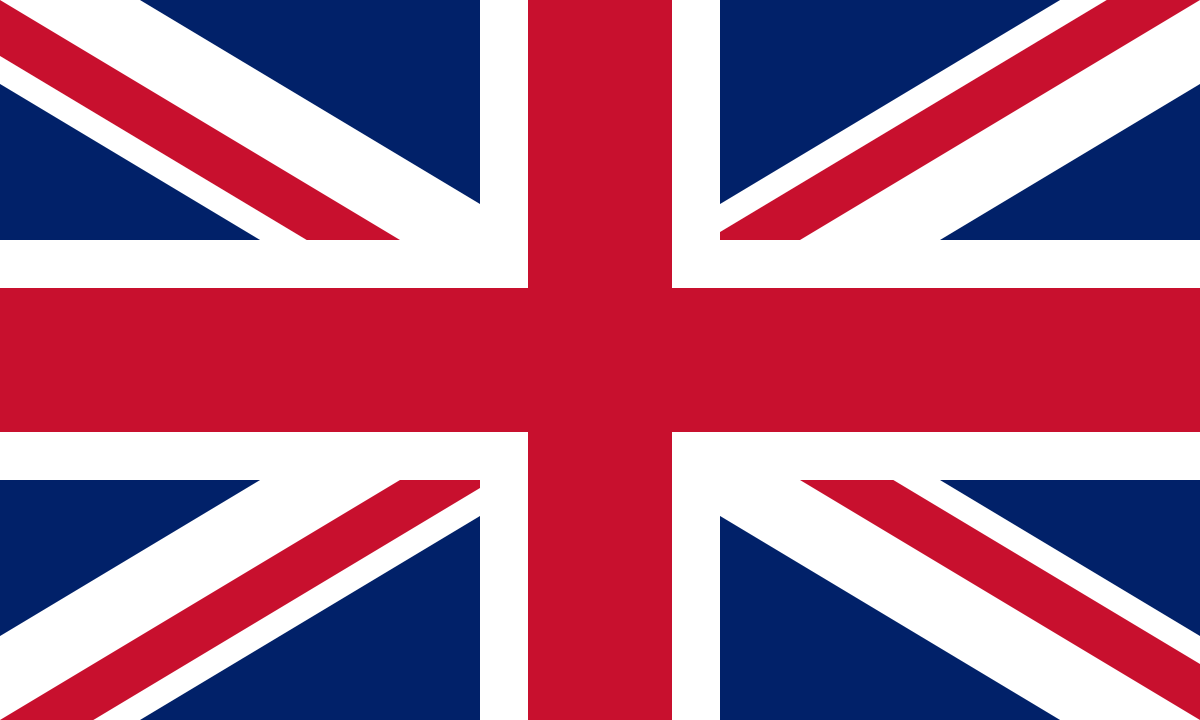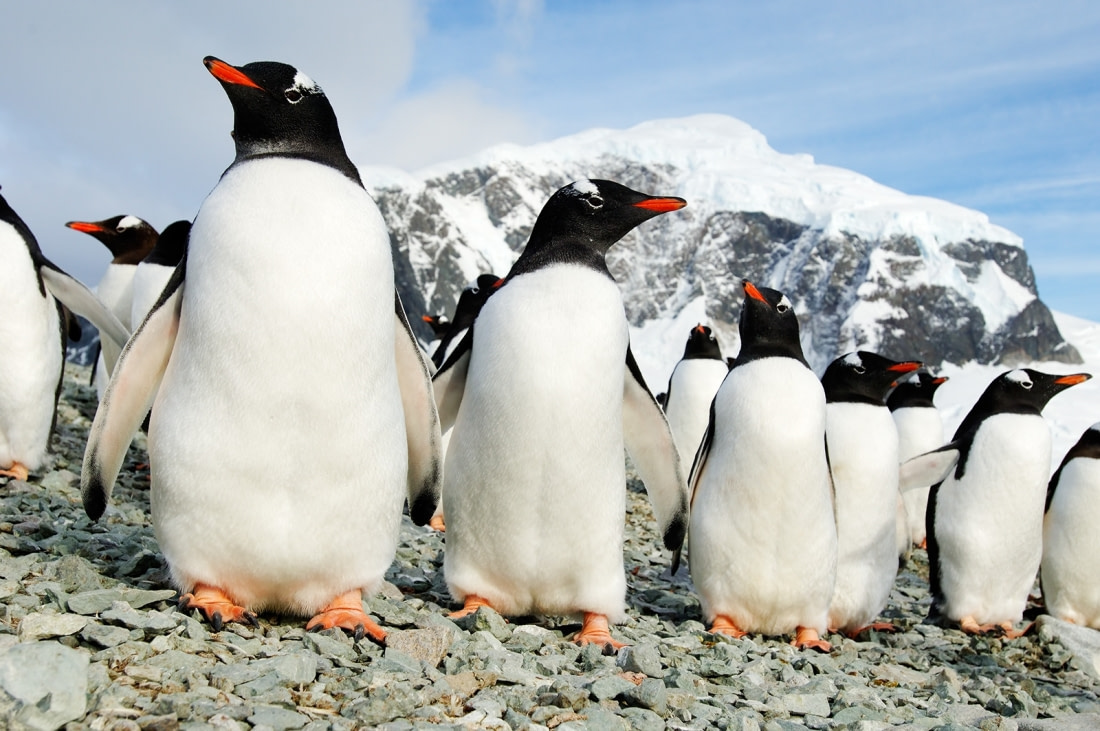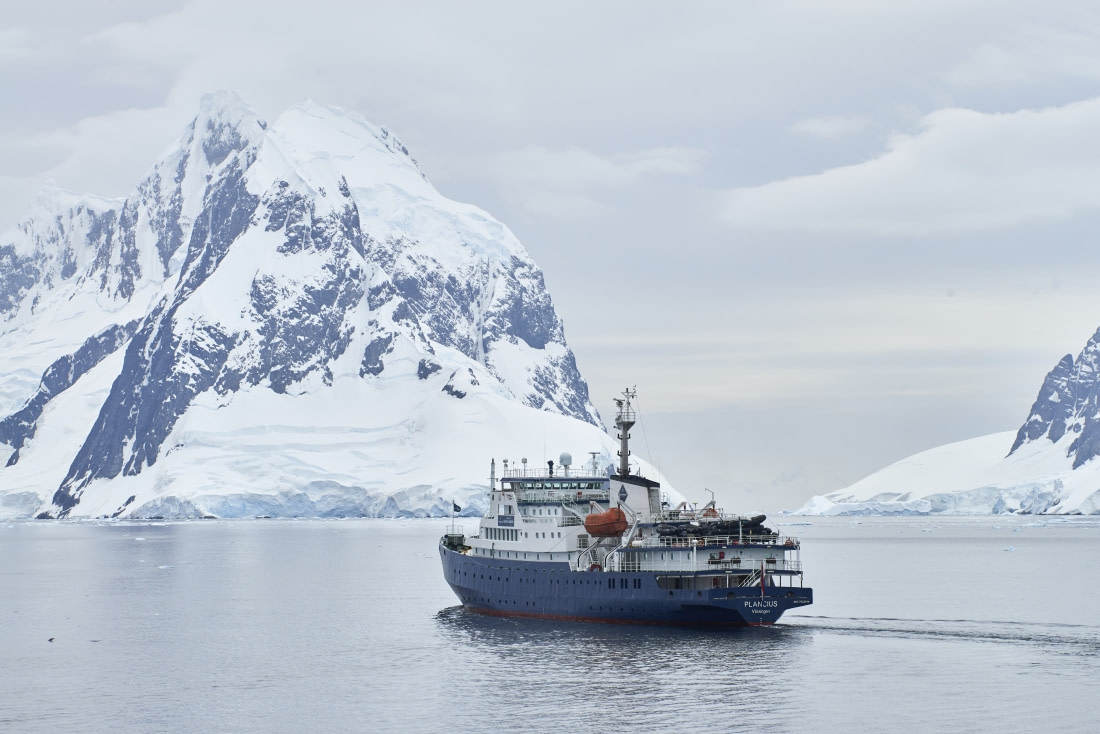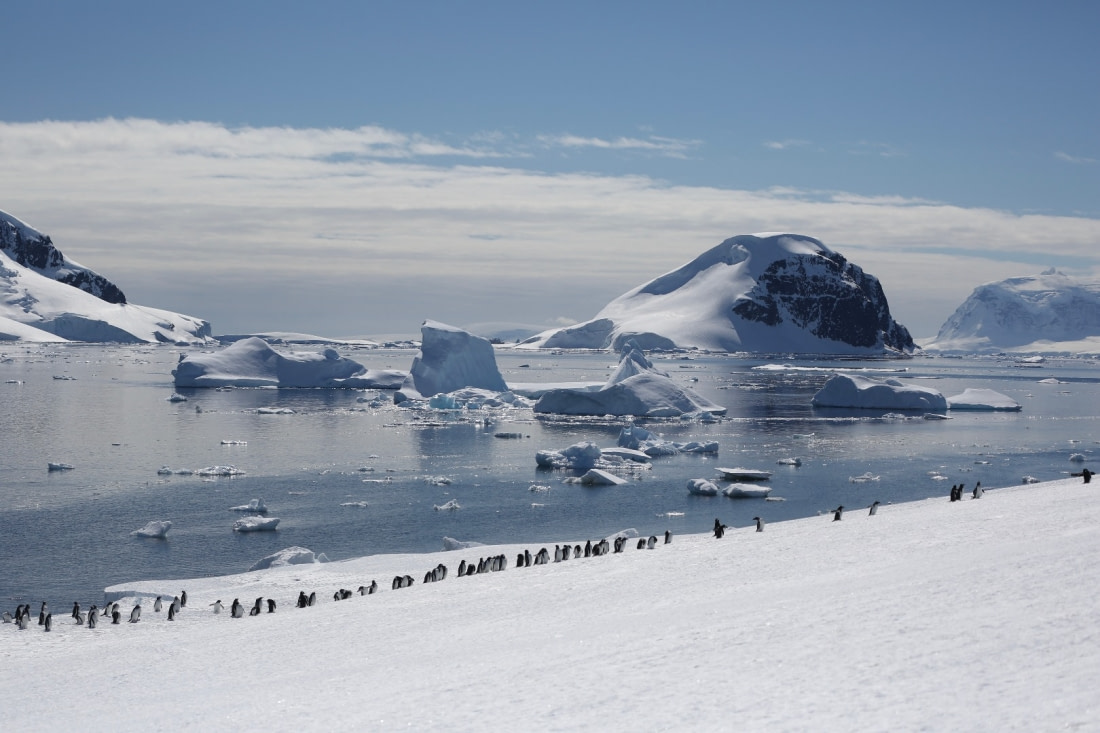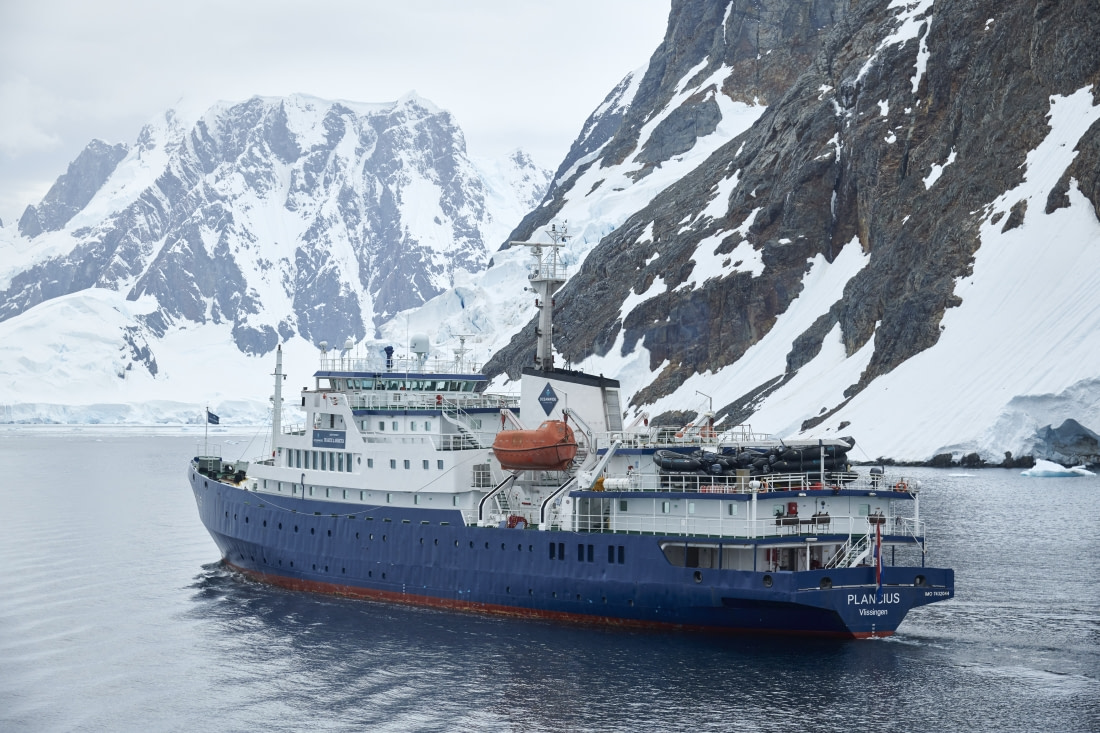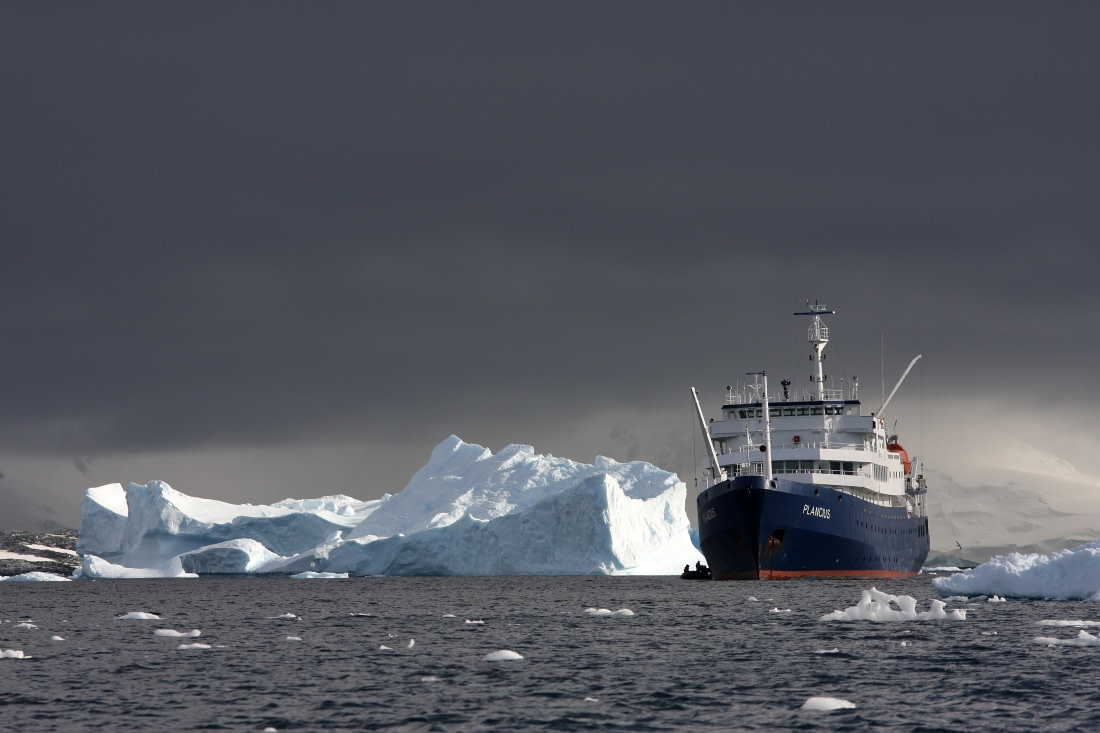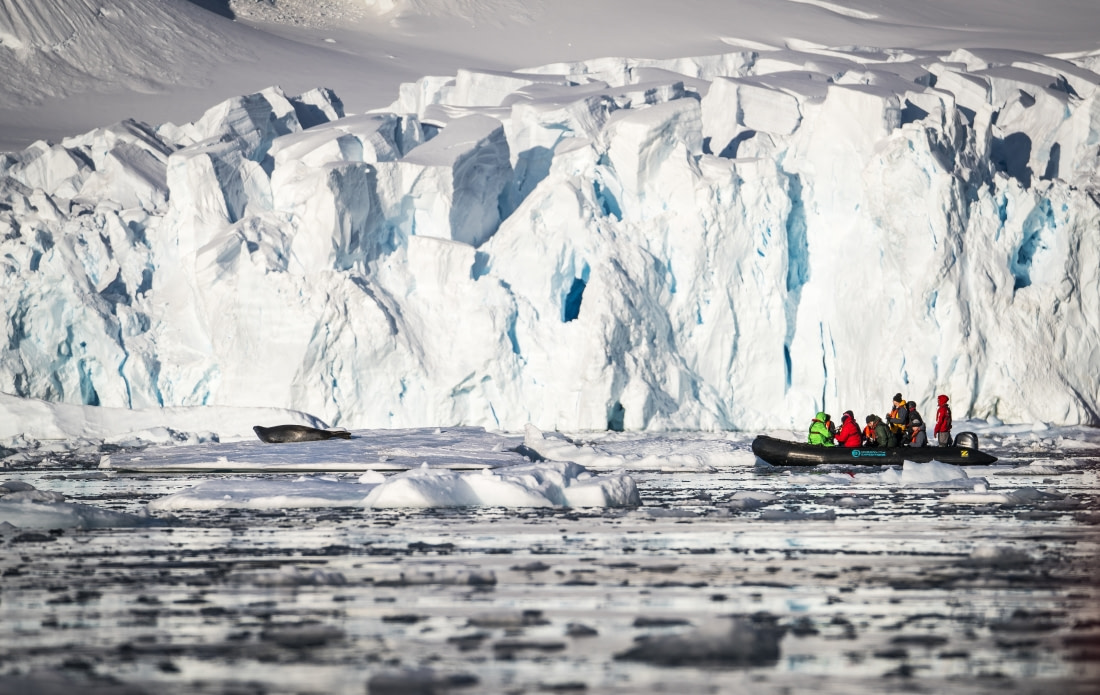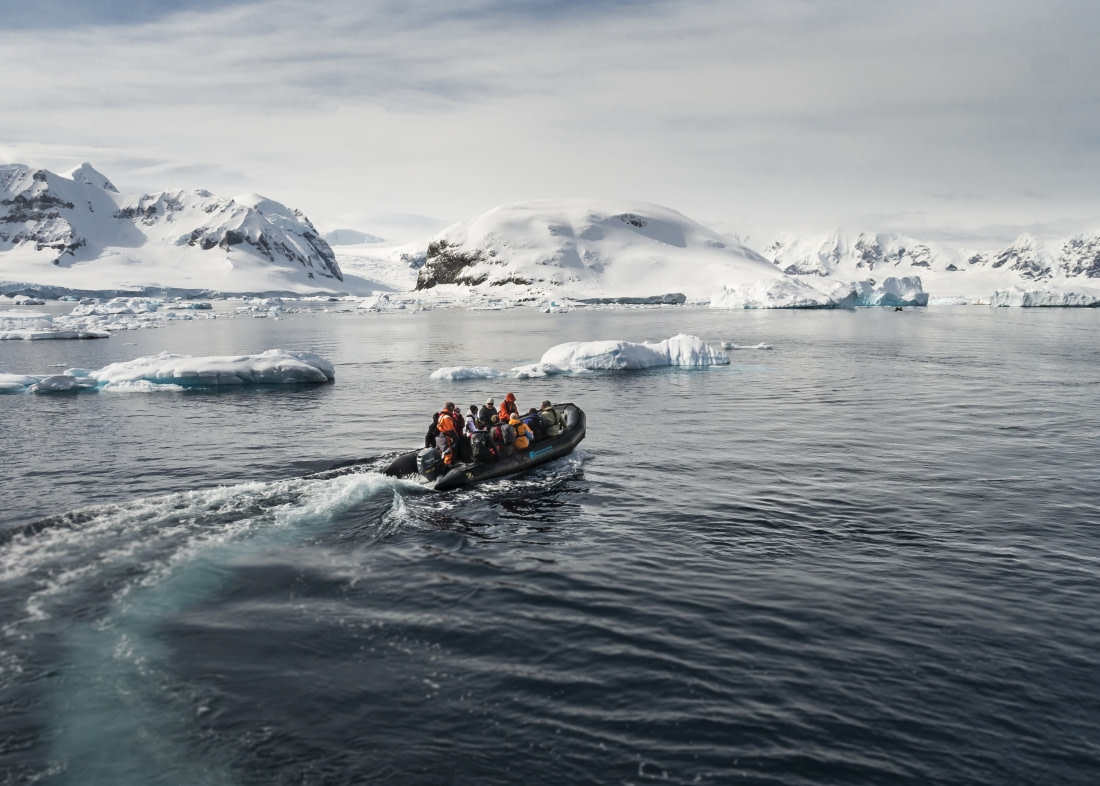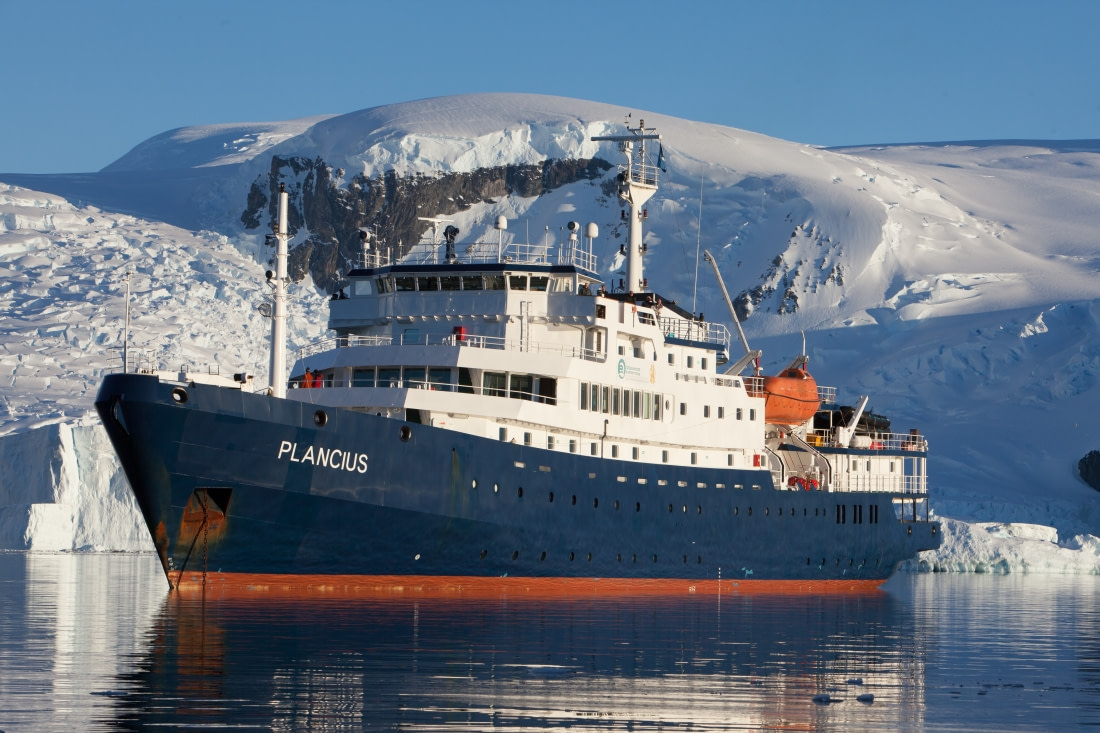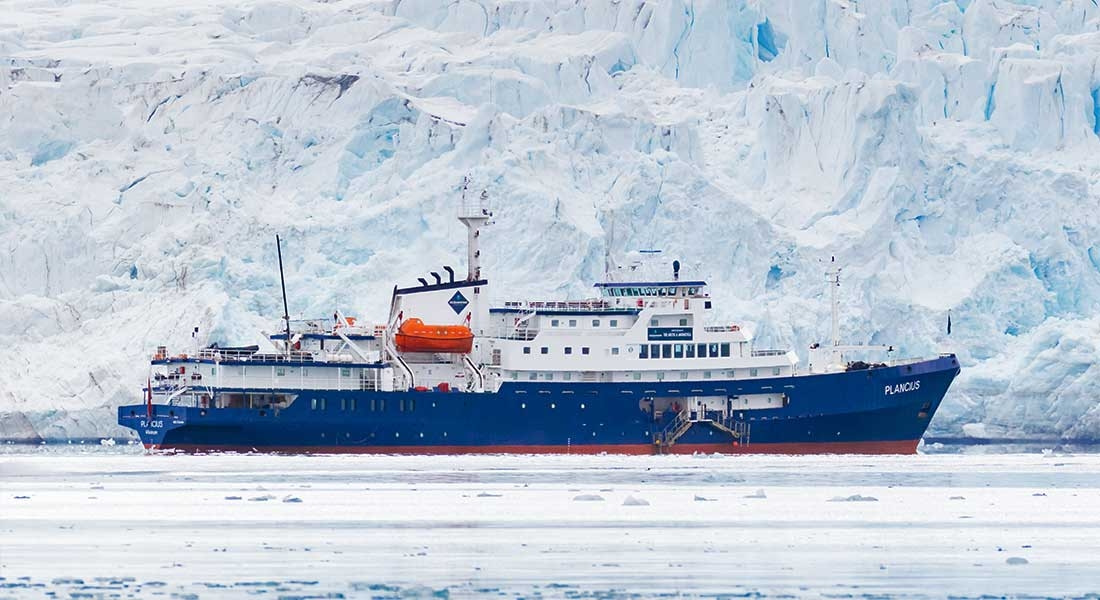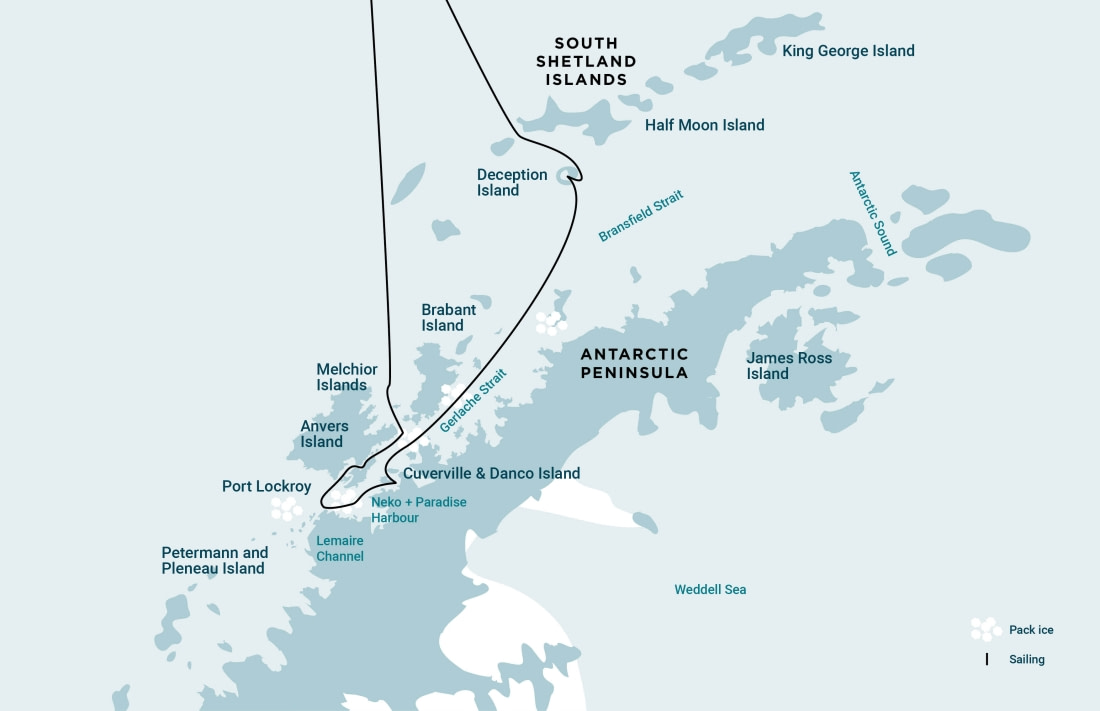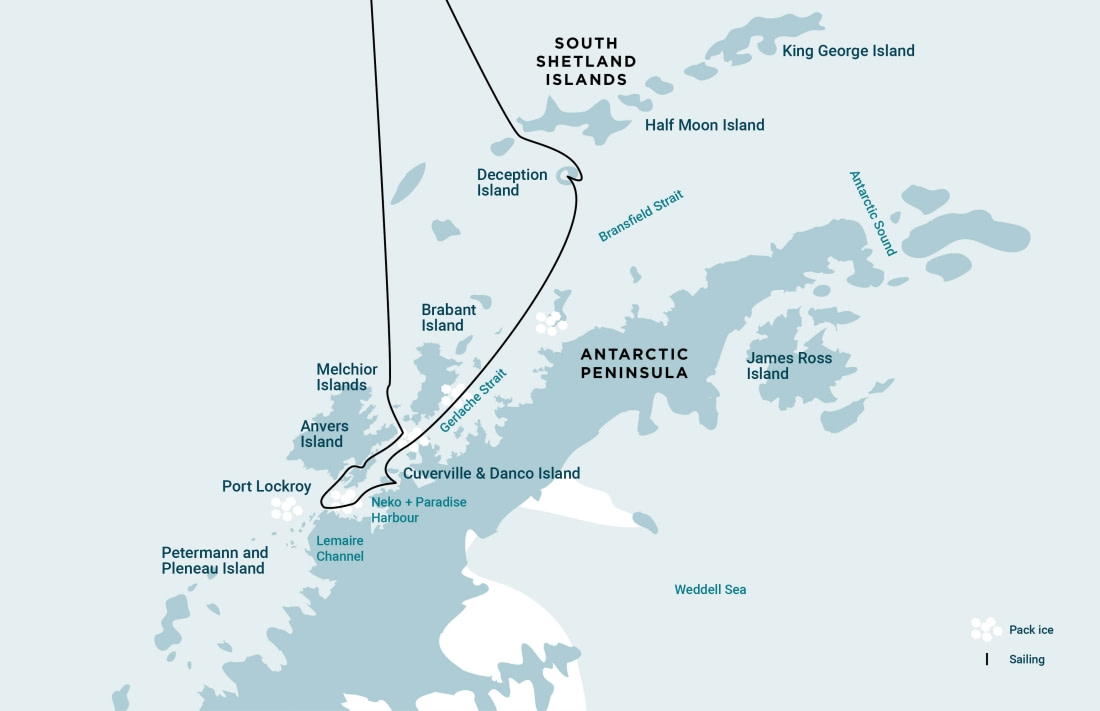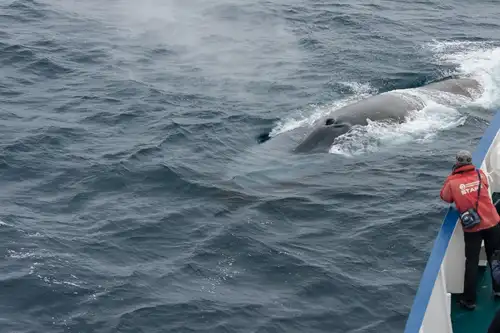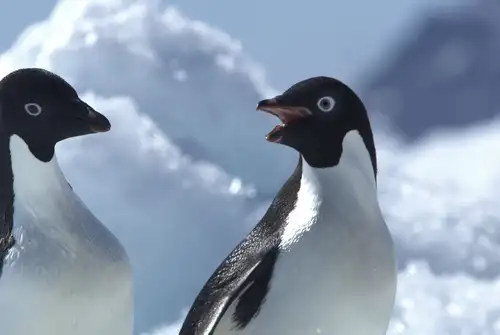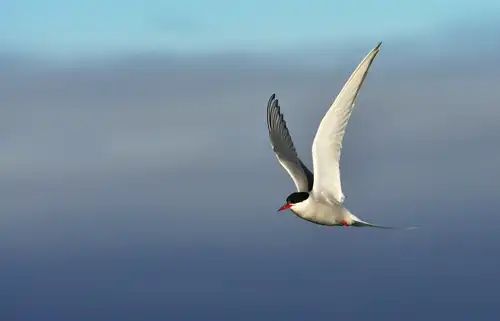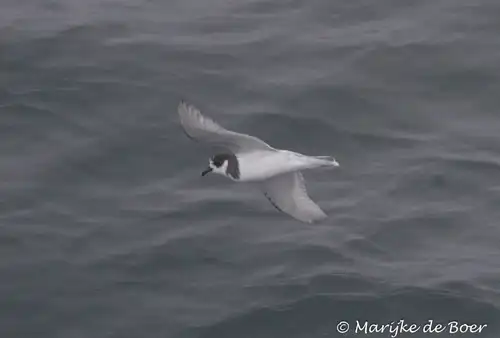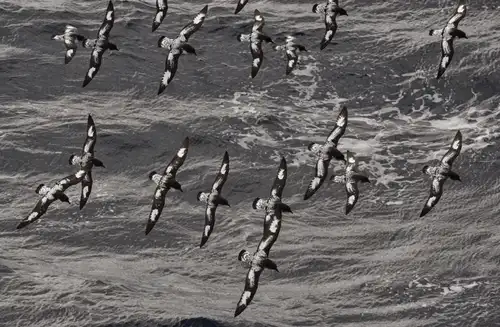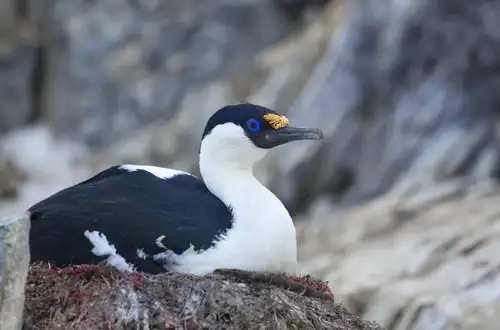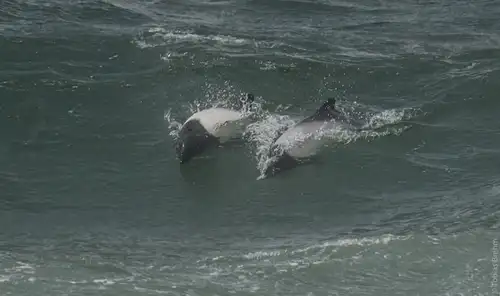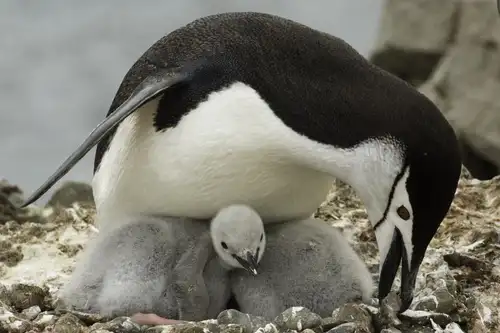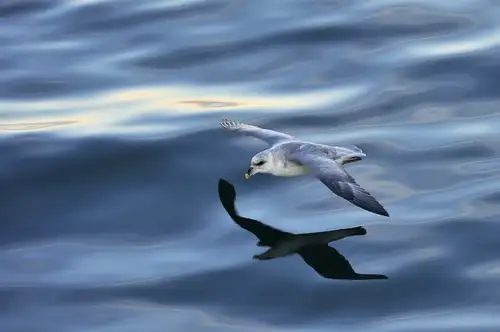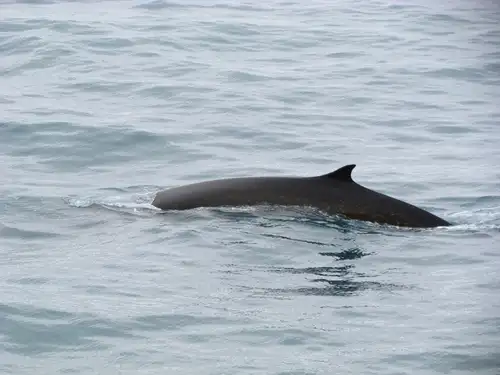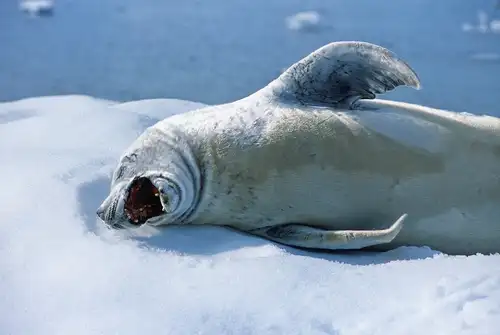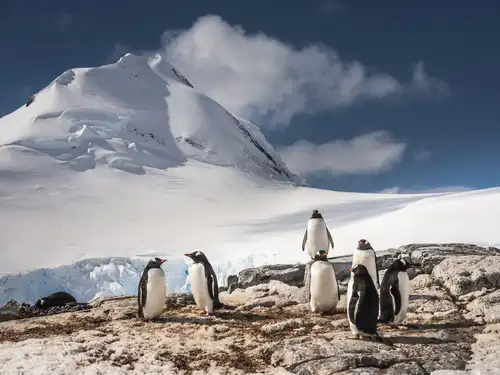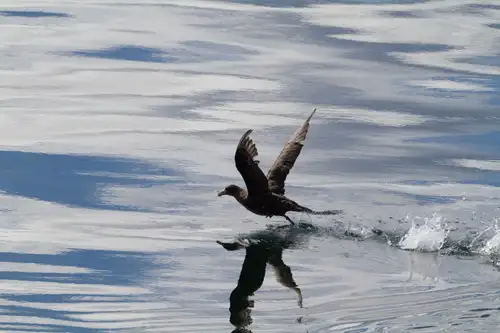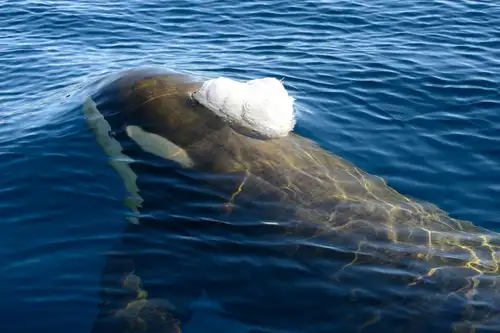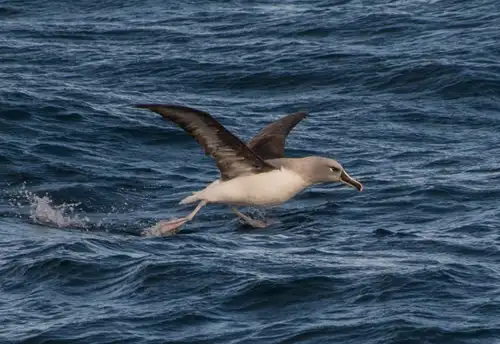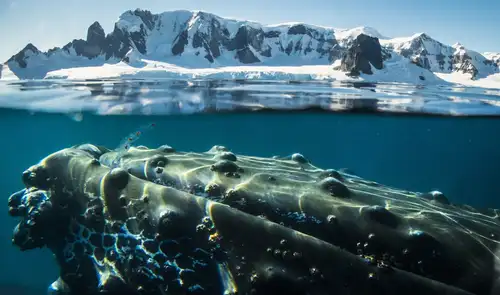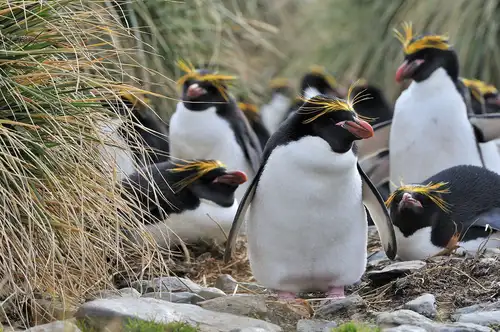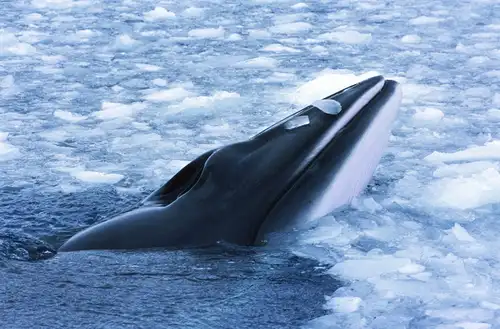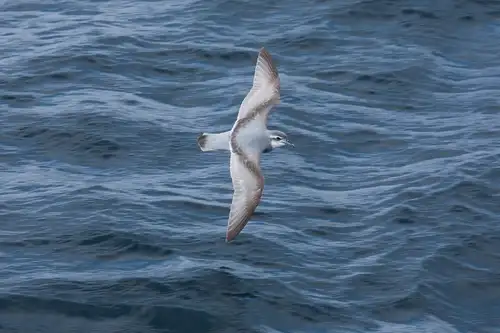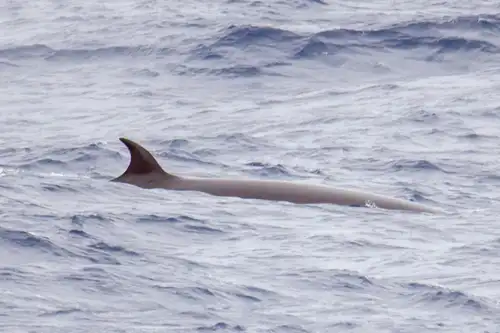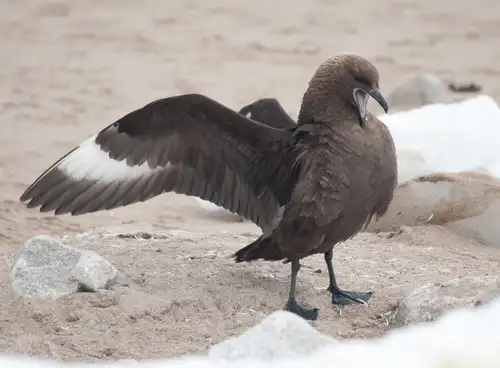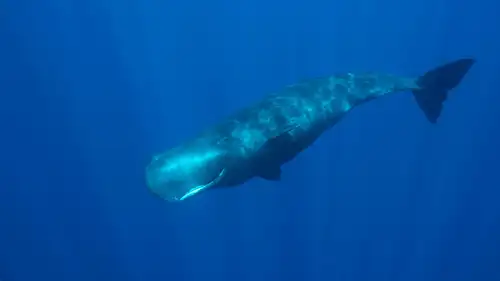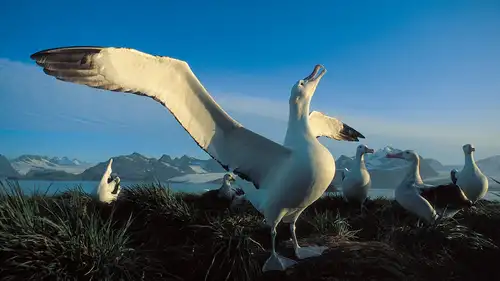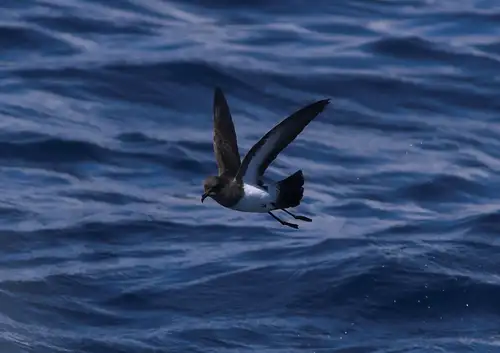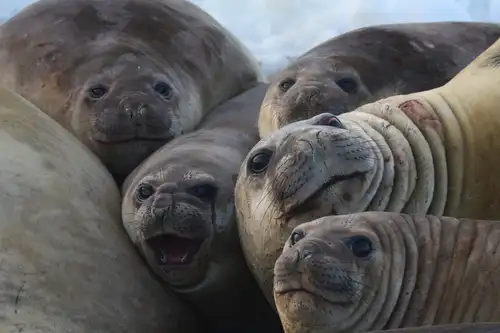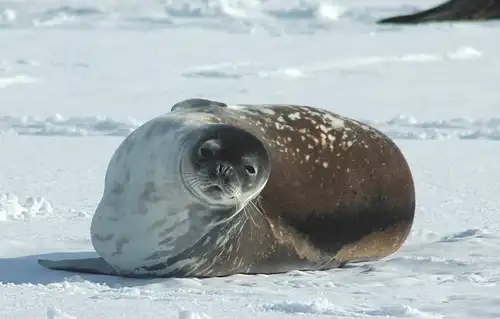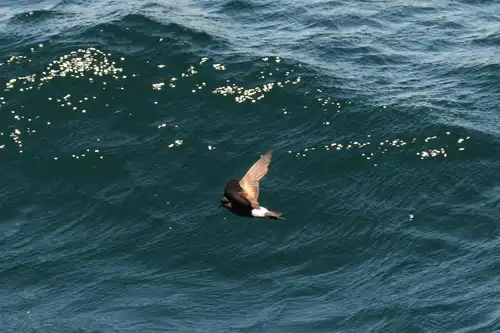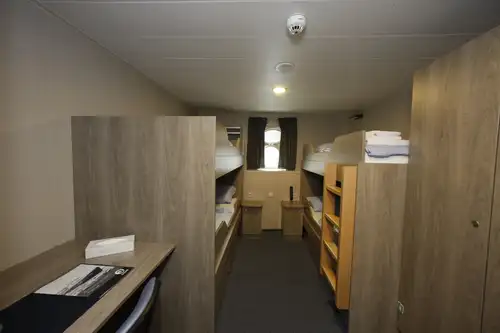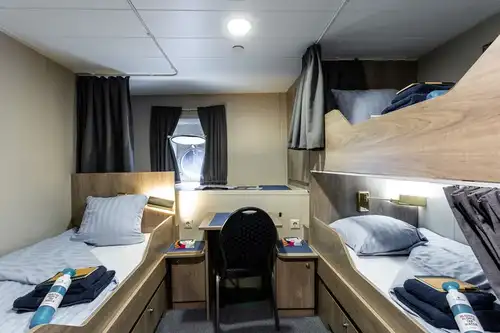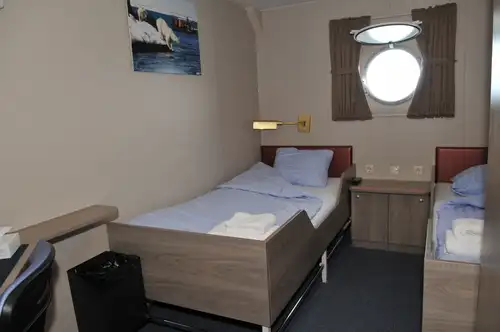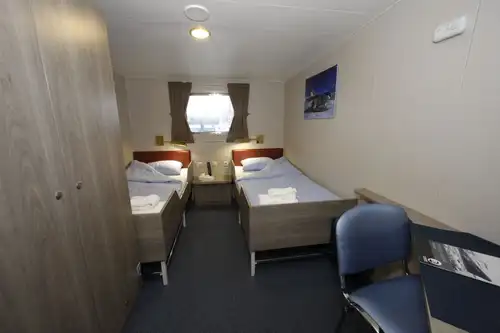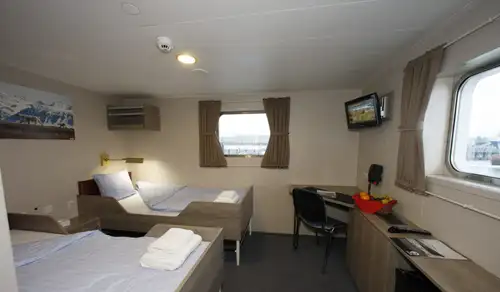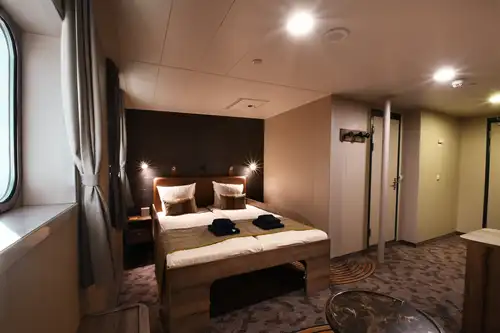
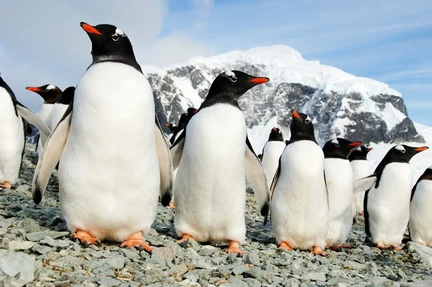
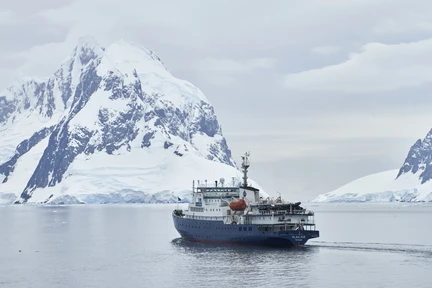
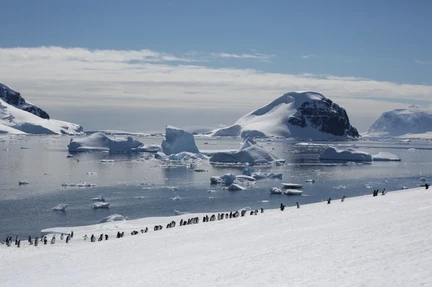
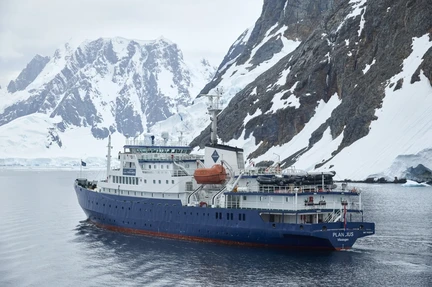
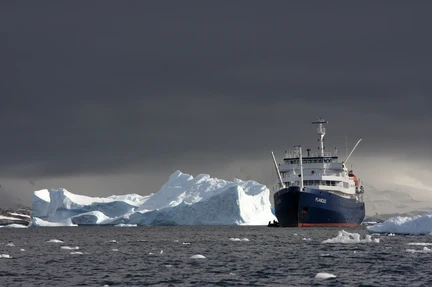
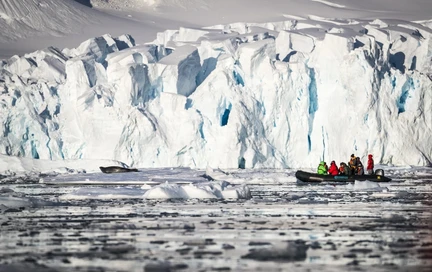
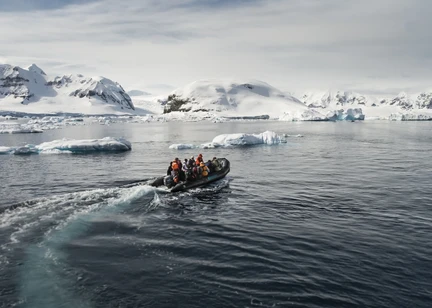

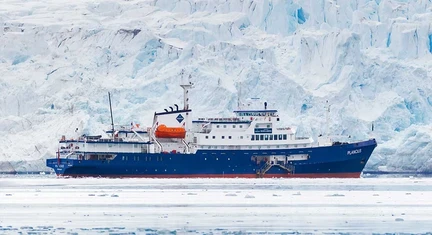
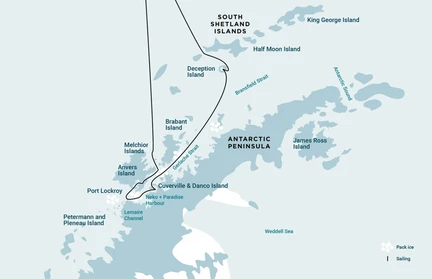
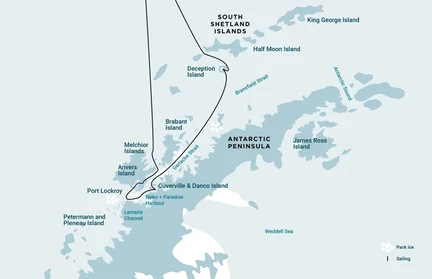
























 11 Days/10 Nights
11 Days/10 Nights




Explore Antarctica on long walks with small groups of up to 24 people, guided by experienced staff. These walks offer a deep dive into the untouched polar landscape, requiring participants to be ready for up to six hours of hiking on semi-rough, rocky, and snowy terrain with significant elevation changes. The pace is steady, but conditions can be tough and change quickly. Good fitness and a willingness to walk for long periods are essential. The total duration depends on site conditions. For those not joining the long hikes, other activities or shore landings will be available.
Start of the Journey
Your expedition begins in Ushuaia, Argentina, known as the southernmost city in the world. In the afternoon, you leave this small town on Tierra del Fuego, also called "The End of the World," and cruise through the mountain-lined Beagle Channel for the evening.
Path of the Polar Explorers
Over the next two days, you cross the Drake Passage, experiencing the same cool salt breezes and rolling seas as the early polar explorers. After passing the Antarctic Convergence, where cold waters meet warmer seas, you enter a zone rich in marine life. You might see wandering albatrosses, cape pigeons, and various petrels.
Enter the Antarctic
Experience gray stone peaks, blue-white ice, and diverse wildlife. You pass the Melchior Islands and Schollaert Channel, sailing between Brabant and Anvers Islands. Possible visits include:
- Danco Island: See gentoo penguins and nearby seals.
- Neko Harbour: Enjoy views of glaciers and snow, with opportunities for a Zodiac cruise.
- Paradise Bay: Take a Zodiac cruise and possibly see humpback and minke whales.
- Port Lockroy: Visit a former British research station and meet gentoo penguins.
When conditions allow, snowshoe around the shore and to Damoy Point.
Scenes of South Shetland
The South Shetland Islands are often misty but offer unique sights. Discover mosses, lichens, and various penguins. At Deception Island, explore an abandoned whaling station and see cape petrels and other birds. Alternatively, visit Half Moon Island to see chinstrap penguins and Weddell seals.
Familiar Seas, Familiar Friends
On your return journey across the Drake Passage, you're greeted by the seabirds you met earlier, now more familiar to you.
There and Back Again
Every adventure must end. It's time to disembark in Ushuaia, carrying memories of your journey as you look forward to your next adventure.

Camping in the Antarctic Wilderness
For a truly immersive polar adventure, our open-air camping activity lets you experience the Antarctic wilderness like few travelers have. We provide the necessary camping gear, including breathable bivouac bags that are wind and waterproof, and polar sleeping bags to keep you warm and comfortable during the enchanting Antarctic night. Experienced expedition guides will assist and supervise all campers.
Explore the Arctic and Antarctic Coastline in a Kayak
Even after exploring shores, mountains, and spotting wildlife, there’s a whole world to discover on the water. Polar kayaking offers a unique way to experience the blue-and-white beauty of the polar seas, visiting stunning ice formations and waterways too small for our ships.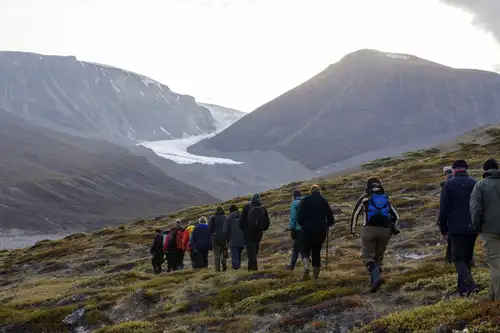
Leave the Vessel Behind on Our Long Hikes Activity
Immerse yourself in the vibrant surroundings of Greenland and Svalbard with our long hikes activity. Enjoy the Arctic summer far from the vessel as you embark on a full-day hike, crossing tundra, rivers, and rugged backcountry.






































































m/v Plancius
Our most longstanding vessel, Plancius, is a classic choice for many of our most popular polar voyages.

Specifications
| Passengers: | 108 passengers in 50 cabins |
| Staff & crew: | Crew 40 | Guides 8 | Doctor 1 |
| Length: | 89 meters (293 feet) |
| Breadth: | 14,5 meters (47 feet) |
| Draft: | 5 meters (16 feet) |
| Ice class: | 1D (Plancius has a Lloyds class notation 100A1 Passenger ship, Ice Class 1D at a draught of 5 meters) |
| Displacement: | 3211 tonnes |
| Propulsion: | 3x Diesel-Electric |
| Speed: | 10.5 knots average cruising speed |
Cabins Gallery


Ship Interior Gallery


Ship Exterior Gallery


M/v “Plancius” was built in 1976 as an oceanographic research vessel for the Royal Dutch Navy and was named “Hr. Ms. Tydeman”. The ship sailed for the Dutch Navy until June 2004 and was eventually purchased by the company. The vessel was completely rebuilt as a passenger vessel in 2009 and complies with the latest SOLAS-regulations (Safety Of Life At Sea). M/v “Plancius” is classed by Lloyd’s Register and flies the Dutch flag.
Perfect for any expedition
M/v “Plancius” accommodates 108 passengers with private toilets and shower in 4 quadruple porthole cabins, 9 twin porthole cabins, 25 twin cabins with windows and 2 twin deluxe cabins, all (ca. 12,5 square meters) and 10 twin superior cabins (ca. 21 square meters). All cabins offer lower berths (one queen-size bed in the superior cabins and two single beds in the twin cabins), except for the 4 quadruple cabins (for 4 persons in 2x upper and lower beds).
Plancius: a vessel with comfort and character
Please be aware that a small number of cabins may have a partially obstructed view due to the design requirements of the ship. The best view is always on the outer deck or the bridge. The vessel offers a restaurant/lecture room on deck 3 and a spacious observation lounge (with bar) on deck 5 with large windows, offering a full panorama view. M/v “Plancius” has large open deck spaces (with full walk-around possibilities on deck 4), giving excellent opportunities to enjoy the scenery and wildlife. She is furthermore equipped with 10 Mark V zodiacs, including 40 HP 4-stroke outboard engines and 2 gangways on the starboard side, guaranteeing a swift zodiac operation.
M/v “Plancius” is comfortable and nicely decorated, but is not a luxury vessel. Our voyages in the Arctic and Antarctic regions are primarily defined by an exploratory educational travel program, spending as much time ashore as possible. Plancius fully meets our demands to achieve this. The vessel is equipped with a diesel-electric propulsion system which reduces the noise and vibration of the vessel considerably. The 3 diesel engines generate 1.230 horsepower each, giving the vessel a speed of 10 - 12 knots. The vessel is ice-strengthened and was specially built for oceanographic voyages. M/v “Plancius” is manned by an international crew of 40 (20 nautical crew and 20 hotel crew), 8 expedition staff (1 expedition leader, 1 assistant expedition leader and 6 guides/lecturers), and 1 doctor.
Dress code
In keeping with our expedition atmosphere, dress on board is informal. Bring casual and comfortable clothing for all activities. Keep in mind that much of the spectacular scenery can be appreciated from deck, which can be slippery. Bring sturdy shoes with no-slip soles and make sure the parka is never far away in case of the call "Whales!" comes over the loudspeaker and you have to dash outside. Wear layers since it is comfortably warm aboard the ship - and often cold on deck.
Currency & payment
Refreshments from the bar and souvenirs will be charged to your cabin. The day before departure you can settle your bill with the Hotel Manager and pay by credit card (Visa or MasterCard) or cash (Euro or Dollar). We do not accept cheques of any kind. The price and standard currency on board our vessels is the Euro. Other currencies may be accepted at the discretion of the hotel manager at prevailing rates.
Electric current
The electrical supply aboard the ship is 220v, 60Hz. Electrical outlets are standard European with two thick round pins. You may need a 220v/110v converter.
Gratuities
The customary gratuity to the ship's service personnel is made as a blanket contribution at the end of the voyage which is divided among the crew. Tipping is a very personal matter and the amount you wish to give is at your discretion. As a generally accepted guideline, we suggest 8-15 Euro per person per day. It is better for the crew, if you can give them cash.
Non-smoking policy
On board our vessels we have a non-smoking policy. It is prohibited to smoke inside the ship. You can smoke in the designated smoking areas. Please respect the wishes of non-smokers.
Your physical condition
You must be in good general health and you should be able to walk several hours per day. The expedition is ship-based and physically not very demanding. Although we spend as much time as possible ashore, you are welcome to remain aboard the ship if you like. To join most excursions, you must be able to get up and down the steep gangway from the ship to the water level to board the Zodiacs. Staff will assist you in and out of the boats. This will become progressively easier with practice. Ashore it can be slippery and rocky. You are travelling in remote areas without access to sophisticated medical facilities, so you must not join this expedition if you have a life-threatening condition, or need daily medical treatment.

The average price for flights (round trip) to Ushuaia
From Jakarta: $2,300
From Singapore: $2,500
From Kuala Lumpur: $1,900
Insurance Requirements:
- Mandatory Insurance: All travelers must have insurance covering medical expenses, accidents, and repatriation/evacuation.
- Recommended Insurance: It is strongly recommended to include cancellation insurance for added protection.
Drone Usage Policy:
- Prohibited: The use of drones is strictly prohibited during the expedition.
Clothing and Gear Recommendations:
- Water-Resistant Coat and Pants: Essential for protection against the wet and windy conditions.
- Layered Underwear: To ensure warmth and comfort in extreme weather.
- Sunglasses: Necessary to protect against the strong UV rays and glare from the snow.
- Gloves: Insulated and water-resistant gloves to keep your hands warm and dry.
- Additional Items: Consider packing a warm hat, thermal socks, and sturdy waterproof boots.
- Voyage aboard the indicated vessel
- All meals throughout the voyage aboard the ship including snacks, coffee and tea.
- All shore excursions and activities throughout the voyage by Zodiac.
- Program of lectures by noted naturalists and leadership by experienced expedition staff.
- Free use of rubber boots and snowshoes.
- Pre-scheduled group transfer from the vessel to the airport in Ushuaia (directly after disembarkation).
- All miscellaneous service taxes and port charges throughout the programme.
- Comprehensive pre-departure material.
- Flights to the embarkation point and from the disembarkation point.
- Pre- and post- land arrangements.
- Passport and visa expenses.
- Meals ashore.
- Personal health Insurance for Medical, Accident and Repatriation/Evacuating.
- All personal expenses, including but not limited to laundry services, bar beverages, and excess internet usage charges.
- The customary gratuity at the end of the voyages for stewards and other service personnel aboard (guidelines will be provided).
- Not during the summer, which is when the majority of our voyages take place. It depends on where you go in the Arctic, but temperatures can get up to 10°C (50°F) and don't tend to drop too far below 0°C (32°F). Antarctica is slightly colder, but still warm in the austral summers, reaching up to 2°C (36°F) depending on your location, and tending not to get too much lower than that during the warm months. You're only likely to experience colder weather during our fall and winter Arctic trips, where temps can range between -34°C to 0°C (-29°F to 32°F). But you'll have the northern lights to keep you warm.
- An ice-strengthened ship is a ship made of steel. These ships are made to get through the ice at Antarctica and the Arctic. Nowadays, most of the ships that cruise to Antarctica and the Arctic are ice-strengthened ships. Ortelius and Plancius are both are ice-strengthened ships. Ortelius has the highest ice-class notation (UL1 equivalent to 1A) and is therefore very suitable to navigate in solid one-year sea ice and loose multi-year pack ice. Plancius has an ice-class notation of 1D. Icebreakers are needed if there is a trade route to keep ice free, if there are military reasons for patrolling in areas with heavy sea ice or if you need to work in heavy ice conditions, particularly in winter. Icebreakers are expensive to build and very expensive in fuel to run (sometimes powered by gas turbines or a nuclear generator). They are uncomfortable to travel in on the open sea.
- No, you are not able to get cash advances on the vessel.
- When you make a confirmed reservation, we require a 40% deposit. But if the reservation is made within two months prior to departure, the full price of the voyage is due at the time of booking.
- The climate in the Antarctic Peninsula is much milder than most people would imagine because it is located near the most northerly part of Antarctica. If you travel to the Antarctic Peninsula during January, which is summertime, you can expect an average temperature of 1 to 2 degrees Celsius (33.8 to 35.6 degrees Fahrenheit). June is the coldest part of the year, and the temperature range is typically -20 to -15 degrees Celsius (-4 to 5 degrees Fahrenheit) during this part of the winter. Precipitation amounts vary throughout the region. On your voyage to the Antarctic Peninsula you can expect at least some rain on occasion. On the other hand, the interior of Antarctica is similar to a desert in that it only receives an annual precipitation amount of 10 cm (3.93 inches).
- Animal lovers who take their holiday in the Antarctic Peninsula will be treated to a diverse list of wildlife that is especially suited to the area's cold climate. It is common to encounter several penguin species such as the Gentoo penguins. Other types of wildlife that can be spotted from an Antarctic cruise or an Antarctic Peninsula land expedition include the Weddell seal, the Antarctic shag and Snow petrels.
- The ship Plancius was built in 1976 as an oceanographic research vessel for the Royal Dutch Navy.
- There are in total 50 cabins at the Plancius: 4 quadruple cabins with private toilet and shower 9 twin porthole cabins 25 twin cabins with window 2 twin deluxe cabins (ca 15 square meters) 10 superior cabins (ca 21 square meters)
You May Also Like


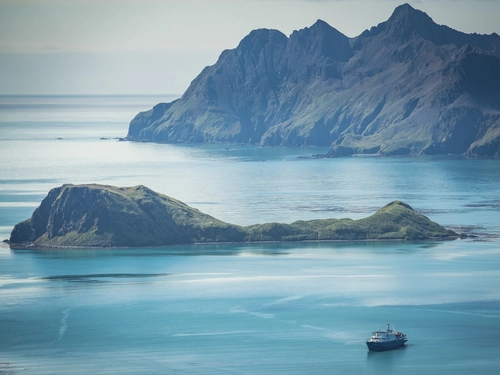
Falkland Islands - South Georgia - Antarctica
 19 Days / 18 Nights
19 Days / 18 Nights
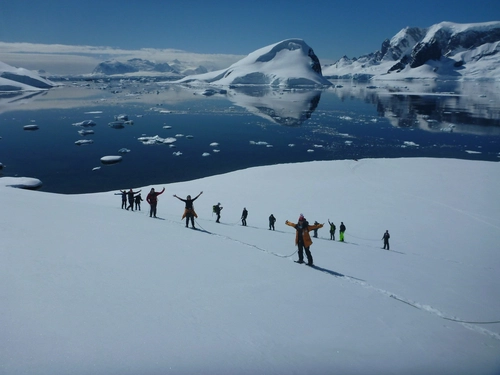
Antarctica - Basecamp - free camping, kayaking, snowshoe/hiking, mountaineering, photo workshop
 13 Days / 12 Nights
13 Days / 12 Nights

Antarctica - Discovery and learning voyage
 11 Days / 10 Nights
11 Days / 10 Nights

Falkland Islands - South Georgia - Elephant Island - Antarctica - Polar Circle
 23 Days / 22 Nights
23 Days / 22 Nights

Antarctica – Uncharted islands of the Deep South
 15 Days / 14 Nights
15 Days / 14 Nights

Deep South Basecamp experience
 14 Days / 13 Nights
14 Days / 13 Nights

Antarctica - Elephant Island - Weddell Sea - Polar Circle - Aurora Australis / Southern Lights
 15 Days / 14 Nights
15 Days / 14 Nights

Antarctica - Whale watching discovery and learning voyage - Aurora Australis / Southern Lights
 11 Days / 10 Nights
11 Days / 10 Nights

Antarctica - Weddell Sea Explorer Basecamp - free polar activities (kayaking, hiking, photo workshop, snorkeling)
 13 Days / 12 Nights
13 Days / 12 Nights

Antarctica - Beyond the Polar Circle - whale watching - Aurora Australis / Southern Lights
 12 Days / 11 Nights
12 Days / 11 Nights

Antarctica - Whale watching
 10 Days / 9 Nights
10 Days / 9 Nights

Falkland Islands - South Georgia - Antarctic Peninsula - Photography special
 21 Days / 20 Nights
21 Days / 20 Nights

Falkland Islands - South Georgia - Antarctic Peninsula
 21 Days / 20 Nights
21 Days / 20 Nights

Falkland Islands - South Georgia - Antarctic Peninsula - Birding
 19 Days / 18 Nights
19 Days / 18 Nights

Antarctica - Discovery and learning + Long hikes
 11 Days / 10 Nights
11 Days / 10 Nights

Bellingshausen Sea / Peter I Island + Ellsworth Land - incl. helicopters
 25 Days / 24 Nights
25 Days / 24 Nights

Antarctica - Weddell Sea Explorer
 11 Days / 10 Nights
11 Days / 10 Nights

Antarctica - Polar Circle - Deep South Discovery voyage - Aurora Australis / Southern Lights
 13 Days / 12 Nights
13 Days / 12 Nights

Antarctica - Whale watching discovery and learning voyage
 11 Days / 10 Nights
11 Days / 10 Nights

Antarctica - Elephant Island - Weddell Sea - Polar Circle
 15 Days / 14 Nights
15 Days / 14 Nights
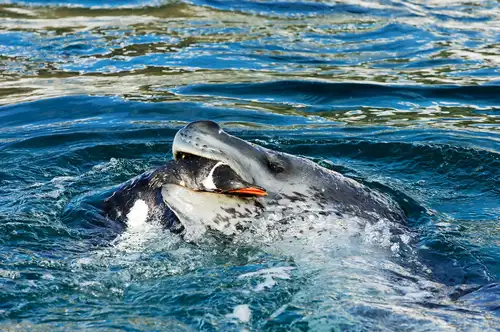
Danger Beneath the Water: 10 Facts About Leopard Seals
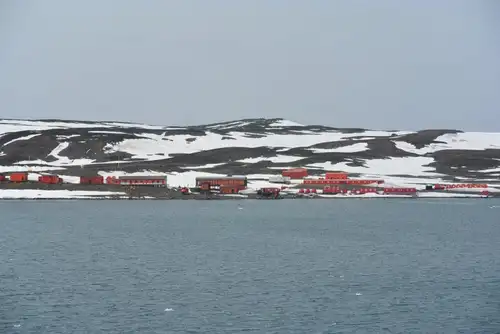
Living the Antarctic Dream
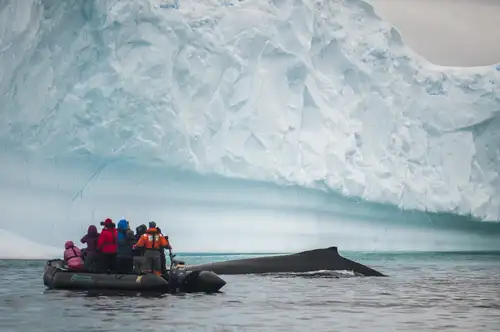
A Day of Whale Watching in Antarctica

Top Antarctica Cruise Experiences for 2025
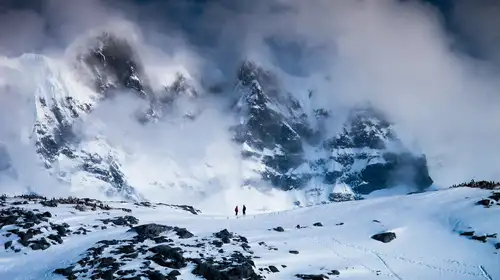
Eight Antarctic Misconceptions
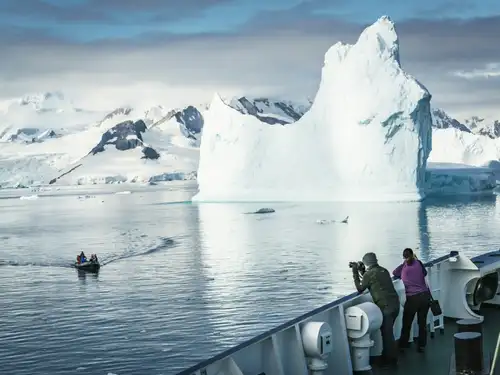
The Classic Polar Cruise: Antarctic Peninsula Facts, Pics, and More
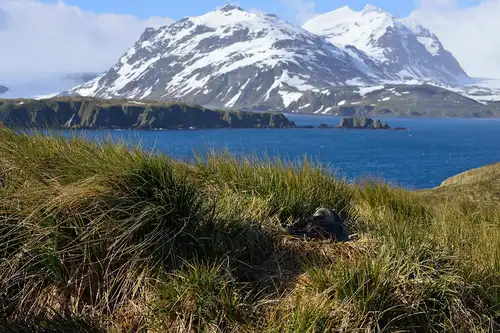
Flowers in Antarctica
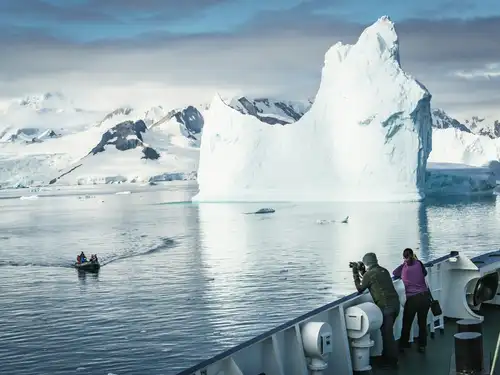
Antarctic Explorer’s Voyage
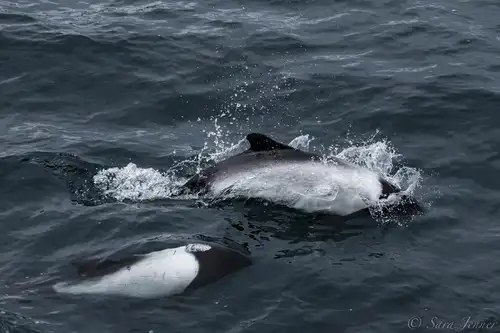
The Small but Social Commerson’s Dolphin
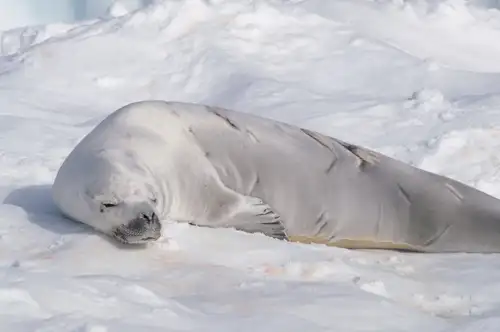
Six Facts About the Crabeater Seals of Antarctica

The Giant Petrels of King George Island
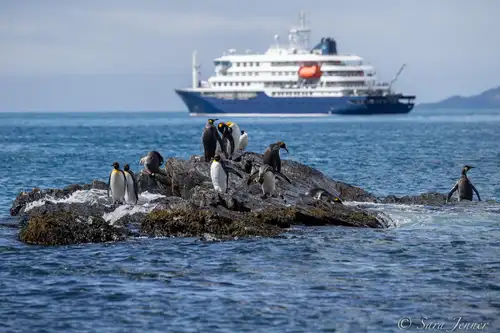
Weddell Sea, Shackleton’s Endurance, and New Swabia
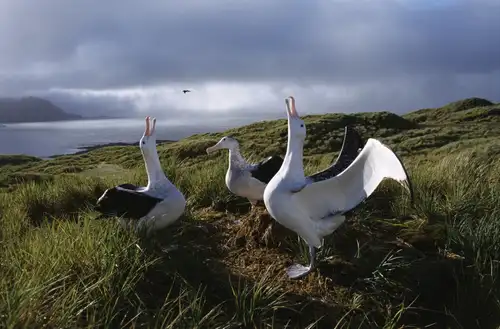
Albatross, penguin and krill research in Antarctica
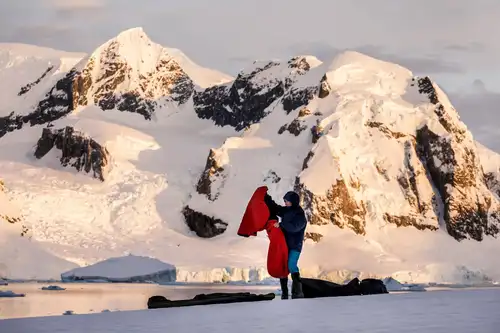
Camping in Antarctica: a True Expedition Experience
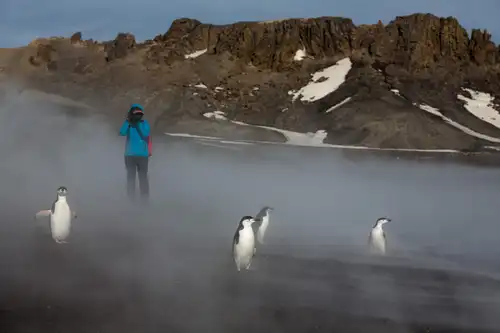
Graham Land: A landscape dominated by volcanoes
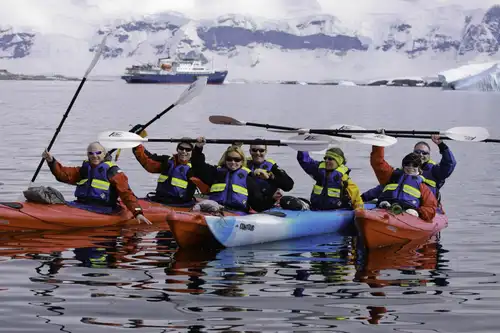
A Day of Basecamp in Antarctica – Paradise Harbour
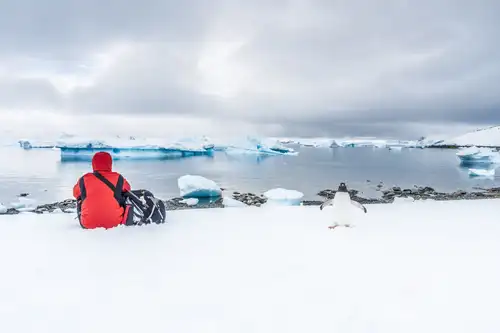
Adding Antarctica to Your Seven-Continents Bucket List

The Eight Great Penguin Species of Antarctica
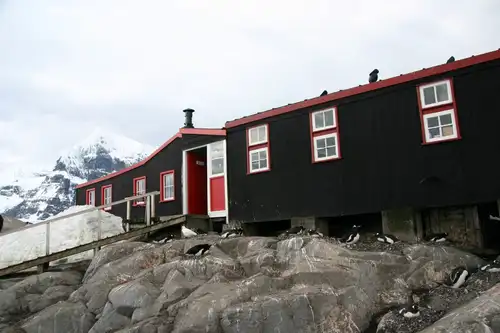
Port Lockroy: History, Post Office, and Resident Penguins



